Beef Kaldereta Recipe
Beef Kaldereta is a Filipino beef stew that slowly simmers chuck roast in a tomato-based sauce flavored with soy, calamansi juice, and spices. Warm, hearty, and savory, it’s what Filipino comfort food is all about. When I’m not serving it on special occasions, I’ll make it for a cozy Sunday dinner.
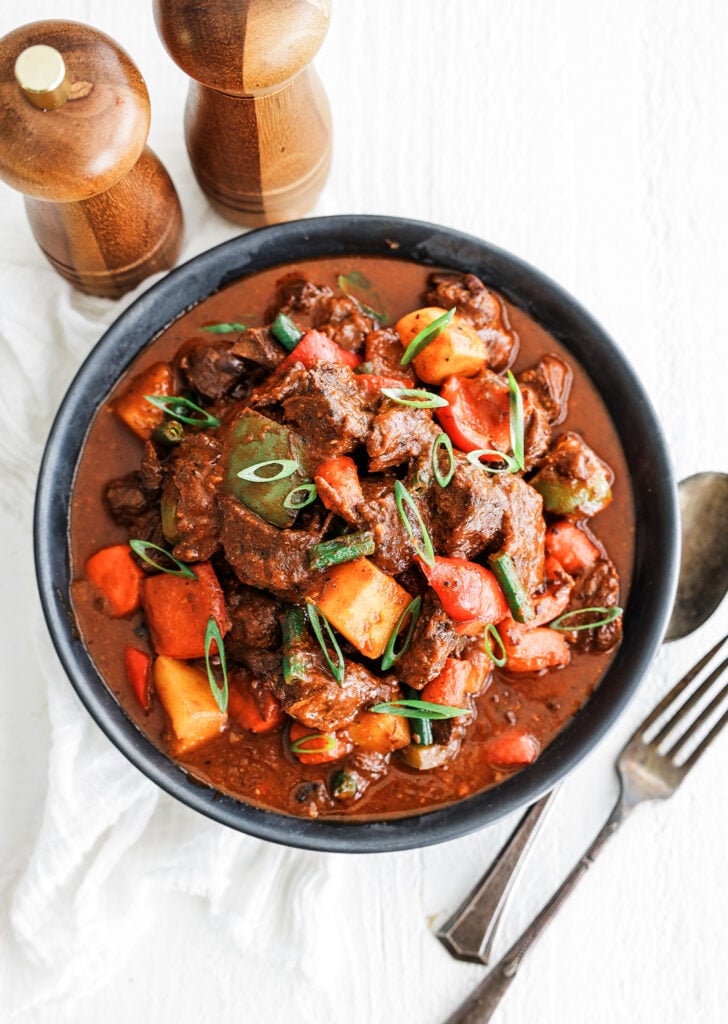
It didn’t take long for me to fall in love with Filipino food. I was officially hooked after testing my Bistek Tagalog recipe, then kept the party going with this glistening Chicken Adobo and this easy Classic Pancit Recipe.
Filipino Beef Kaldereta
I’m really excited about this kaldereta recipe because beef stew is a meal I make on repeat all fall and winter long. Since it’s a classic Filipino comfort food, it’s a little different from the Westernized stew or pot roast you already know. A few traditional ingredients and techniques add unique layers of sweet, tangy, and umami flavors that I can never get enough of.
While the dish does have some Spanish influence (the word “kaldereta” comes from the Spanish “caldera,” meaning “cauldron”), Filipinos have made the recipe their own over time. The recipe can vary depending on where you are (some versions use pork, goat, or chicken), but I’ve kept mine pretty close to the classic version. It’s not 100% authentic, but it still captures its comforting roots.
It takes a good amount of time to put beef kaldereta together, but I never regret taking the time to make it. Chunks of soy sauce and calamansi juice-marinated beef are slowly simmered in a sauce flavored with simple herbs and spices and thickened with liver spread. Some sautéed veggies are stirred in at the end before the rich stew is ready to be enjoyed with rice.
One bite and you’ll see why I’m obsessed with it. My family loves it, too… It’s always a crowd-pleaser at our parties and for special dinners.
Ingredients and Substitutions

- Beef – I used well-marbled chuck roast for this recipe. Beef short ribs, brisket, or shank work, too.
- Marinade – I marinated the beef in soy sauce and calamansi juice (a small citrus fruit common in Filipino cuisine). If you need a substitute for calamansi juice, use lime or lemon juice instead.
- Oil – I reach for any neutral cooking oil I have at home, like canola, vegetable, or avocado oil.
- Vegetables – I love loading my beef stews with a variety of vegetables, including potatoes, carrots, green beans, and bell peppers. Yukon Gold potatoes are my favorite because they stay creamy and don’t fall apart easily. Red or russet potatoes can also work.
- Aromatics – I added caramelized red onions and plenty of garlic to build on the flavors.
- Tomatoes – Some tomato paste and canned tomato puree add acidity and sweetness.
- Stock – Beef stock is the obvious choice, it being a beef stew recipe and all, but chicken stock or even water with a beef bouillon cube will work as well.
- Seasonings – I like bay leaves, crushed red pepper flakes, coarse salt, and freshly cracked black pepper.
- Liver – To stay true to the classic kaldereta recipe, I thickened the stew with beef liver spread. I usually make mine from scratch because it’s so easy, but store-bought is also fine. You can buy it in cans at Asian or Filipino grocery stores. If you can’t find it, use soy sauce or miso paste instead.
- Peanut butter – This is optional, but I like adding a spoonful or two for a nutty depth.
How to Make Beef Kaldereta
Marinate the beef: I start by combining the meat, soy sauce, and calamansi juice in a large mixing bowl. I’ll cover the bowl with plastic and marinate the beef for at least 4 hours or overnight.
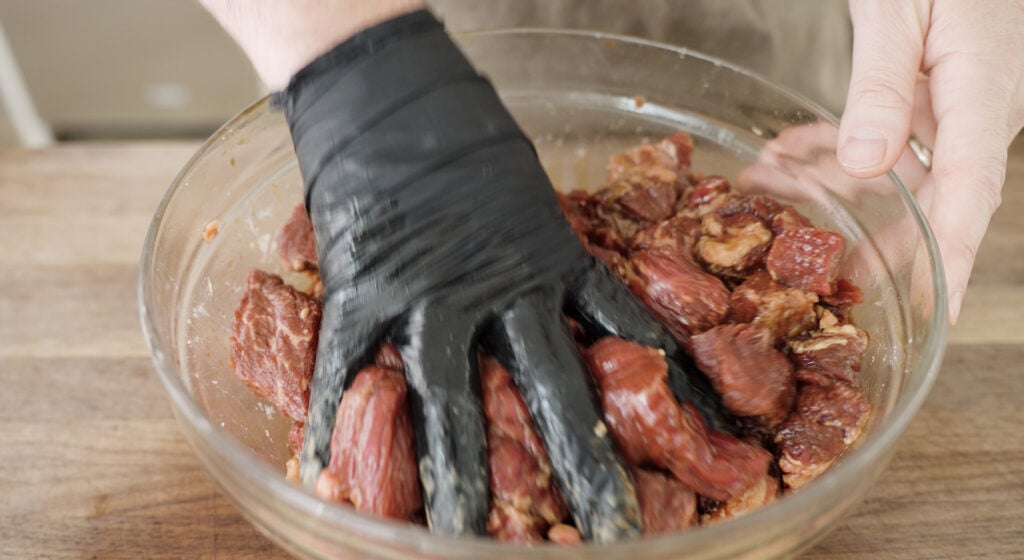
Sauté the potatoes and carrots: I sauté the potatoes and carrots in a large rondeau or cast-iron pot until they start to turn golden around the edges. I transfer them to a plate once browned.

Sauté the green beans and peppers: I add a little more oil to the empty pot, then toss in the green beans and bell peppers. I sauté them until lightly browned, then move them to the plate with the potatoes and carrots.

Caramelize the onions: Finally, I can move on to the onions. I’ll caramelize them in the empty pot with oil and salt until they turn deep golden brown. This usually takes around 15 minutes.

Add the garlic: To finish, I stir in the garlic and cook until it’s fragrant. I transfer the onions and garlic to a separate plate and set them aside.

Brown the beef: After cranking the heat back up to high, I’ll heat up some more oil and add the marinated beef to the pot. I sear it until it’s browned on all sides.

Build the flavors: I return the onions and garlic to the pan, stir in the tomato paste, and let everything cook together until the color darkens slightly and smells caramelized.

Deglaze and simmer: I deglaze the pot with beef stock and stir in the canned tomato puree. I almost always fill the empty tomato sauce can with 1 cup of water, swirl it around to catch every last drop of flavor, and pour that in, too.

Season and slow cook: I season the stew with the bay leaves, red pepper flakes, and a pinch of salt. Next, I cover the pot and let it cook on low to medium heat for about 2 ½ hours.

Add the finishing touches: Once the beef is fall-apart tender, I stir in the liver spread and peanut butter.
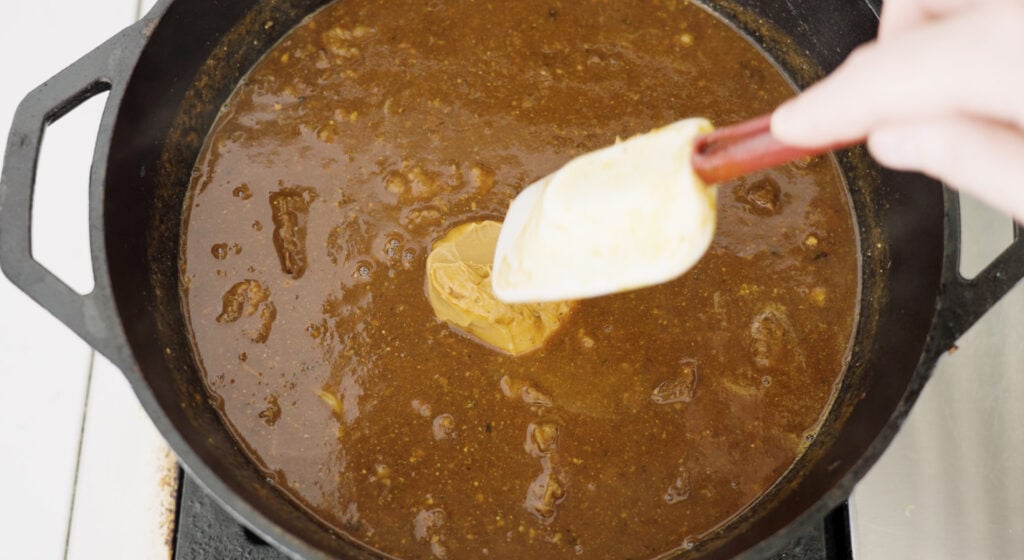
Reheat the vegetables: Finally, I dump the chilled sautéed vegetables back into the pot, stir everything together. I let it simmer until the vegetables are warmed through.
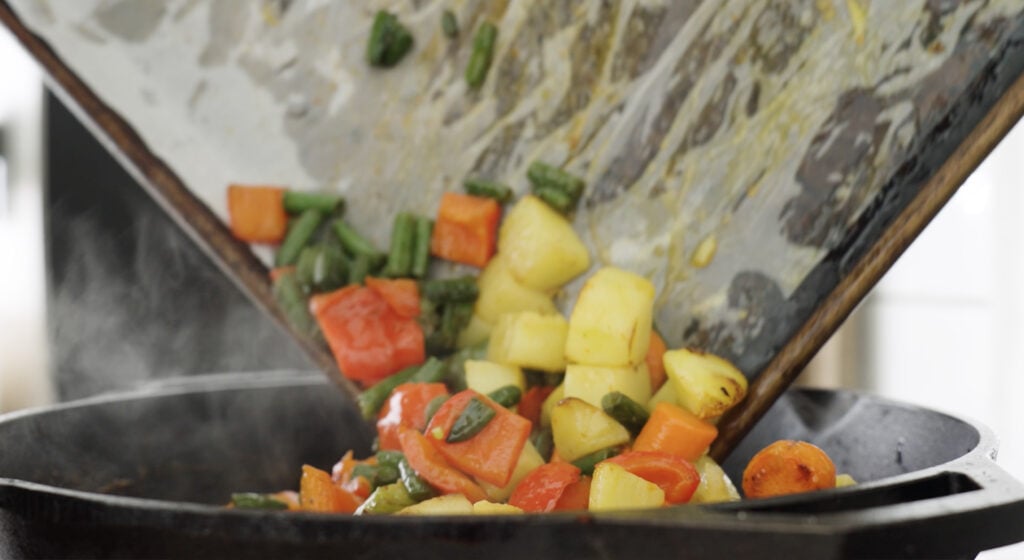
Season and serve: I give the stew one last taste and adjust the flavors needed, then serve it with rice.
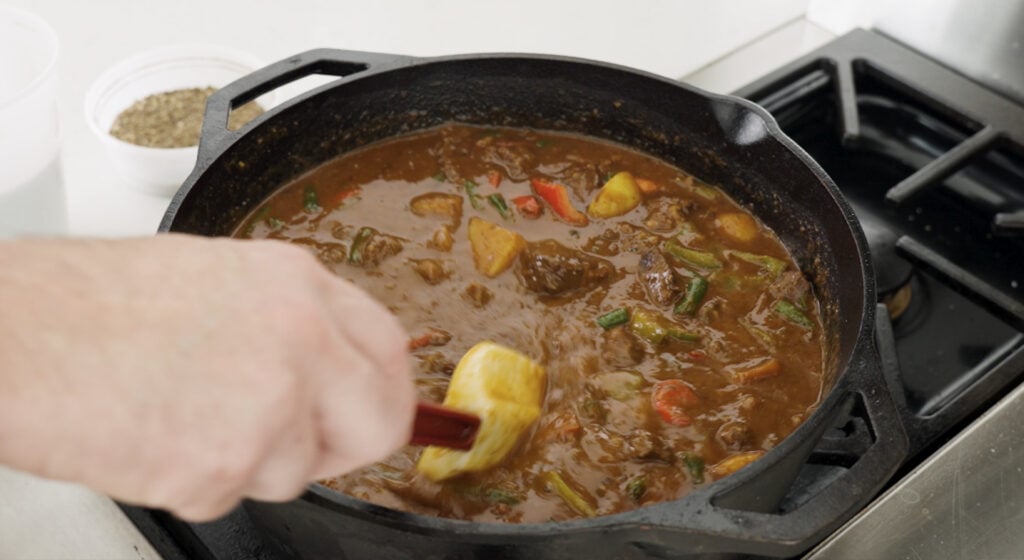

Chef Tip + Notes
I know I’m in for something delicious when I make beef kaldereta simply because of how long it takes. That’s why my #1 tip for making this is to have lots of patience. The beef should ideally be marinated overnight (but 4 hours will still give it good flavor), the vegetables need to be sautéed in stages, and the stew should be left to simmer over low heat for 2 ½ hours. Yes, it takes time, but those layers of well-developed flavors are what make every bite so special.
- Don’t clean the pot: Each vegetable sautéed in it adds serious flavor to the stew. I never clean the pot in between rounds. Instead, I’ll just deglaze it with the beef stock and scrape up any stuck pieces of veggies at the bottom (that’s where the flavor is).
- Brown the beef in batches: I have to sear the chuck roast in at least two batches because I don’t have a big enough pot to fit them all without overlapping. This always gives the pieces a gorgeous golden brown crust, so I don’t mind the extra time it takes.
- Check for doneness: I always know the beef is ready when it shreds easily with a fork and when a meat thermometer measures its internal temperature between 200ºF and 205°F (93º and 96°C).
- Customize it: You can add a splash of fish sauce or Worcestershire sauce near the end to deepen the umami. You can also stir in peas, sautéed mushrooms, or spinach if those are the vegetables you have in the fridge. A briny pop from some olives or pickled jalapeños would be nice, too.
Serving Suggestions
Kaldereta is a meal you serve on holidays and special occasions. But if you’re anything like me and my family, you won’t want to wait. We make this year-round. Sometimes we go all-out, pairing it with lumpia (crispy spring rolls) for some crunch and pork adobo to really get everyone excited.
Personally, I love serving this stew with steamed white rice. I just love how the grains soak up all of that great flavor.
Make-Ahead and Storage
Make-Ahead: Like most slow-cooked stews, kaldereta tastes better the next day. You can make it a day ahead to let those flavors mingle or just keep it warm over low heat for a few hours before serving.
How to Store: Leftover beef kaldereta keeps for 4 days in the fridge or 3 months in the freezer. I like to pack the leftovers in individual airtight containers for easy reheatable meals.
How To Reheat: Gently warm the stew on the stovetop until it’s warmed through. It may thicken in the fridge, but a splash of beef stock or water will loosen it.
More Beef Stew Recipes

Beef Kaldereta Recipe
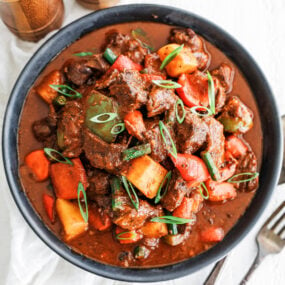
Ingredients
- 3 ½ pound chuck roast, cut into 1” to 2” inch cubes
- ½ cup soy sauce
- ¼ cup calamansi juice, substitute with lime or lemon
- 8 tablespoons cooking oil
- 5 peeled large cut Yukon gold potatoes
- 3 peeled thickly sliced carrots
- 1 cup thickly sliced green beans
- 2 seeded red bell peppers, cut into 1” squares
- 1 seeded green bell pepper, cut into 1” squares
- 2 peeled small diced red onions
- 8 finely minced garlic cloves
- 3 tablespoons tomato paste
- 4 cups beef stock
- 2 cups tomato puree
- 2 bay leaves
- ½ teaspoons crushed red pepper flakes
- ¼ cup liver spread, optional
- ¼ cup creamy peanut butter, optional
- coarse salt and freshly cracked pepper to taste
Instructions
- Add the beef, soy sauce, and calamansi to a large bowl and mix until the meat is completely coated. Cover with plastic wrap and refrigerate for 4 to 24 hours.
- In a large rondeau or cast-iron pot over high heat, add 2 tablespoons of oil. Place the potatoes and carrots in the pot, gently season with salt, and sauté for 4 to 5 minutes or until lightly browned. Set to the side. Next, add 2 more tablespoons to the pot over high heat, then add in the green beans and peppers, gently season with salt, and sauté for 4 to 5 minutes or until lightly browned. Set aside with potatoes and carrots. Place in the fridge.
- Pour in 1 tablespoon of oil, add in the onions, gently season with salt, and saute for 5 minutes over medium heat until lightly browned. Then turn the heat down to low and cook for 10 to 12 minutes, stirring occasionally. They should be well browned at this point.
- Stir in the garlic and cook just until fragrant. Then set the onions and garlic aside on a separate plate.
- Add the remaining oil over high heat, then once it begins to smoke, add in the beef and cook until browned on all sides. This takes about 3 minutes per side. It’s ok to do this step in batches.
- Once well browned, add the onions and garlic back to the pot, stir in the tomato paste, and cook until everything in the pot becomes dark, about 3 to 4 minutes.
- Deglaze with the beef stock, then pour in the tomato sauce. At this point, I usually fill the can or cup of tomato sauce up with 1 cup of water and swirl it around to get all that goodness, then add it to the pot.
- Place in the bay leaves, pepper flakes, and salt. Stir and taste. It should be delicious. Put on the cover and cook over low-to-low medium heat for 2 ½ hours or until the beef is tender and easily shreds apart.
- Next, stir in the optional liver spread and peanut butter. The liquid should immediately turn to a thick sauce consistency.
- Stir in the sauteed and chilled potatoes, carrots, green beans, and peppers, and cook for 4 to 5 minutes to reheat.
- Adjust any seasonings with salt and pepper and serve with rice.

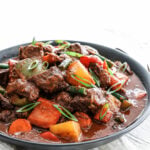

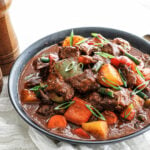
I tried this recently, and it was fantastic. I did a few modifications (no potato, am cutting carbs back) and a few minor changes based on what I had available (no need to detail, just stick close to the directions as-is). This recipe lives up to the promise made in the accompanying video, and will very definitely be a regular in the rotation.
Appreciate you giving it a try!
Chef Billy, your Kaldereta is a culinary delight, an outstanding recipe, indeed! The additions of whole olives, sautéed mushrooms and a little jalapeño will take it to the next level. I can’t wait to make it. Thanks for sharing!
My pleasure! Thanks for giving it a shot!
Could you use a mixture of turnip and potato to cut down on the carbs?
Sure, give it a try.
OH WOW CHEF! THIS LOOKS DELICIOUS. IT IS WORTH A SHOT. I LOVE ALL IF THE INGREDIENTS TOO. MAYBE WHILE THE BOYS ARE AT THE LAST BBQ COMPETITION OF THE YEAR HERE IN OUR NECK OF THE WOODS I WILL HAVE ALL DAY TO MAKE THIS. FOR WHEN THEY GET HOME. THANKS CHEF FOR THE RECIPE. I CAN’T WAIT TO ME THIS.
Appreciate you giving it a try!
Thanks, Chef.
I will try this and will follow your recipe. I have my own and my kids and friends love it. Let’s see which recipe they like most, yours or mine. I know, i am very competitive (just a little).
Thank you for giving it a shot!
Chef,
My son-in-law to be is Filipino. I would love to make this dish when he comes over for Sunday dinner. What type of rice would you recommend be served with this dish? Love your recipes and your style of culinary teaching. Thank you for generously sharing your culinary talents. Have a pleasant day. – Denise
I serve it up with steamed white rice- you can check out my recipe at https://www.billyparisi.com/how-to-cook-rice-perfectly-every-single-time/
Chef,
My son-in-law to be is Filipino. I would love to make this dish when he comes over for Sunday dinner. What type of rice would you recommend be served with this dish? Love your recipes and your style of culinary teaching. Thank you for generously sharing your culinary talents. Have a pleasant day. – Denise